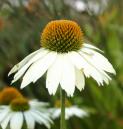528. SESAMUM.—BENNÉ. From Se'samum in'dicum Linné, a plant growing to the height of 4 or 5 feet, native to the East Indies, but long cultivated in Asia and Africa; from the latter country it was introduced by the negroes into Southern United States. Both the leaves and the seeds are used, and a fixed oil expressed from the latter.
528a. THE LEAVES are oblong-lanceolate, from 75 to 125 mm. (3 to 5 in.) long, heart-shaped at base; pubescent, prominently veined beneath. They abound in a gummy matter to such an extent that two leaves stirred in a cup of water will make a sufficiently thick mucilage for use as a demulcent.
528b. THE SEEDS are used chiefly as a source of the fixed oil, of which they contain from 50 to 60 per cent. They are used by the southern negroes as food. Ovate, flattened, about 3 to 4 mm. (1/8 to 1/6 in.) long; externally yellowish-white to pale brown (in one species, S. orientale, purplish-brown), with four longitudinal ridges, and, on the pointed end, a somewhat prominent hilum; internally whitish, oily; taste bland.
528c. Oleum Sesami.—TEEL OIL. BENNÉ OIL. A yellowish, limpid, transparent fixed oil, thinner at ordinary temperatures than most of the fixed oils; odor slight; taste bland, nut-like. It has a specific gravity of 0.919 to 0.923, and congeals to a yellowish-white mass at -5°C. (-23°F.). It is often used to adulterate olive and almond oils, in which it may be detected by shaking a portion of the suspected oil with an equal weight of concentrated hydrochloric acid; a bright emerald-green color will usually be produced, changing to blue, then violet, and finally to deep crimson on the addition of about one-tenth its weight of cane-sugar and agitating.
CONSTITUENTS.—Contains, olein (76 per cent.), myristin, palmitin, stearin-resinoid compound, higher alcohol, C25H44O, sesamin, C11H12O3, crystalline.

